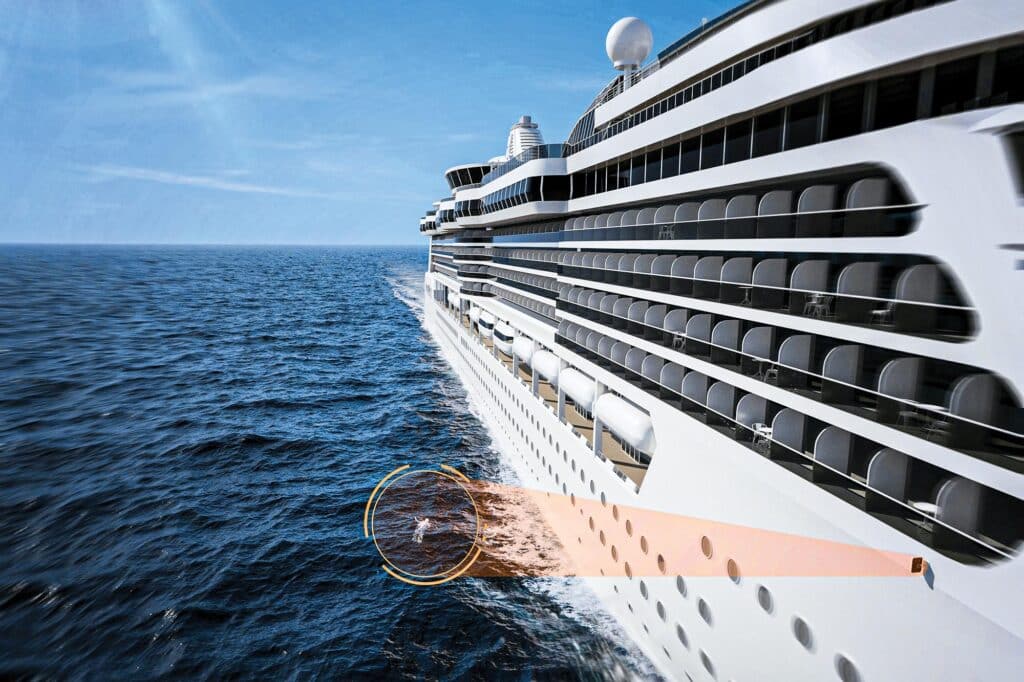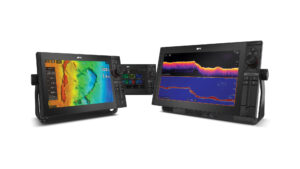
“Person overboard!“
Few phrases conjure darker fears among mariners. The good news, of course, is that contemporary beacons and geofence-breaching pendants can swiftly alert a skipper and crew about an MOB emergency, and can often help with rescue efforts. The less-than-cheery news, however, is that this equipment requires crewmembers, guests and family to carry or wear the equipment. This scheme can also presuppose that a person who has gone overboard is still conscious, treading water and capable of activating a beacon, probably in a seaway, maybe at night.
For the owners and captains of superyachts that carry at least 18 feet of freeboard, MARSS Group’s groundbreaking MOBtronic system provides safety without active user participation.
The Cruise Vessel Security and Safety Act of 2010 mandates that all cruise ships operating in US waters carry equipment that can detect or capture imagery of people who have gone overboard. The resulting ISO standards are strict: Systems must achieve a 95 percent probability of detection while recording no more than one false alarm per day, on average.
Flash-forward to today: UK-based MARSS has developed a solution called MOBtronic, which it has been selling to a few superyachts longer than 300 feet. While MOBtronic currently has a significant freeboard requirement, it employs active-detection technologies rather than pendants or beacons. It can autonomously sense a person overboard and immediately advise its human-on-the-loop operator.
MARSS is also exploring a solution with lower freeboard requirements for smaller yachts. While this technology is not currently available, MOBtronic offers a look at what’s possible when sensors and hybrid intelligence converge.
With regard to hardware, each installation involves a network of MOBtronic sensor pods that are installed along a vessel’s upper decks. Collectively, this equipment creates 360 degrees of coverage. There’s a virtual or physical server running NiDAR CORE, which is MARSS’ hybrid intelligence system that blends detection technologies and human input. There’s also a dedicated touchscreen display. Each sensor pod measures 14.1 by 10 by 3.6 inches, weighs 14.55 pounds and carries an IP66/67 rating. Each pod houses Doppler-enabled, microsize solid-state radars that constantly sweep an area measuring roughly 262 feet long and 26 feet wide (and at least 18 feet high). The package also incorporates a thermal-imaging camera and a processor. Additionally, owners can spec a daylight camera, but this isn’t required by ISO standards.
For scale, a large cruise ship might be fitted with 12 sensor pods, while a 300-plus-foot yacht might carry six.
“The sensor pods themselves have computers built into them, and they are doing most of the heavy-lift processing,” Mike Collier, MARSS’ business development manager, says of the radar- and video-feed analytics. “It’s very light on data that has to go back to the central server.”
The way MOBtronic works starts with radar, which effectively serves as the system’s tripwire. From there, it progresses to thermal imagery and analytics. Each MOBtronic radar pipes its signal to its processor, which has been trained via digital signal processing to identify an overboard person’s volume, size, shape and velocity (think bird mode, but for finding human beings).
Should the radar signal detect a possible match, the pod’s thermal-imaging camera begins working to verify, via video analytics, if this is actually a person in the water.
“It’s a five-stage process,” Collier says. “It takes data from the radar and does two calculations on that, and then it looks at the thermal-imaging-camera data and does some analytics on that as well. And if both things match, then an MOB alarm is raised.”
A human operator is then notified, and that person decides whether and how to escalate the situation. Go-to procedures include conducting head counts, notifying rescuing authorities and nearby traffic, and launching rescue craft and drones.
MOBtronic provides the vessel’s networked navigation system with its GPS location at the time of the emergency. In turn, the nav system can often calculate the person overboard’s predicted set and drift. Some nav systems can also cue a networked camera to follow that real-time position.
MOBtronic doesn’t track the person in the water, at least not outside the area of sensor coverage—but Collier says this isn’t the point. “The system was always focused on the detect part because that’s the most difficult part,” he says. “The bit that was always missing from the puzzle was accurate detection of someone falling from a vessel, and that’s what we focused on. The operator of the vessel can make the decision what they do next.”
As for the system’s 18-foot freeboard requirement, which is currently a limiting factor for many yachts, Collier says it has more to do with meeting and exceeding ISO standards than it does with sensor blind spots.
“It’s really difficult to achieve 95 percent probability of detection and only one false alarm a day,” he says. “We need to give the radar sufficient time to create a track … and for that track to continue all the way down to the water.”
Relaxing the freeboard requirement for use outside of the cruise-ship sector is already in the works. “It won’t be the same technology,” he says. “It might be something slightly different.” One possibility is to add a form of AI called machine learning to the camera feed, which could help MOBtronic understand what’s happening faster and with greater accuracy.
In addition to superyacht-level freeboard requirements (and costs), the system will generate some human-on-the-loop work for the bridge or helm watch. That said, these drawbacks are small prices to pay for an active, autonomous detection system that requires zero participation from the people it’s protecting—especially on a charter yacht, or one with landlubber guests who make unseamanlike decisions. Going forward, this technology could be a compelling safety proposition for many yachts. After all, few things assuage fear faster than situational awareness.









